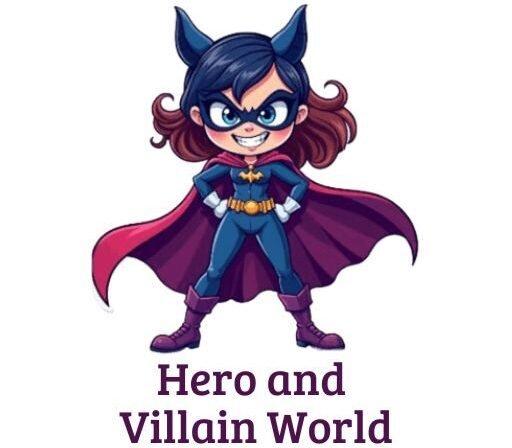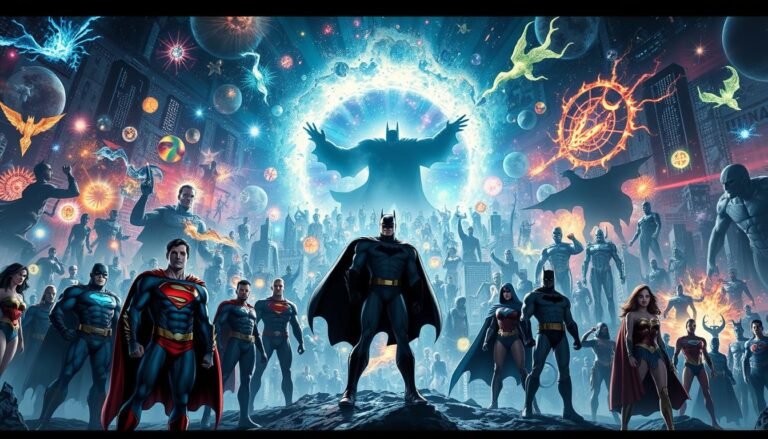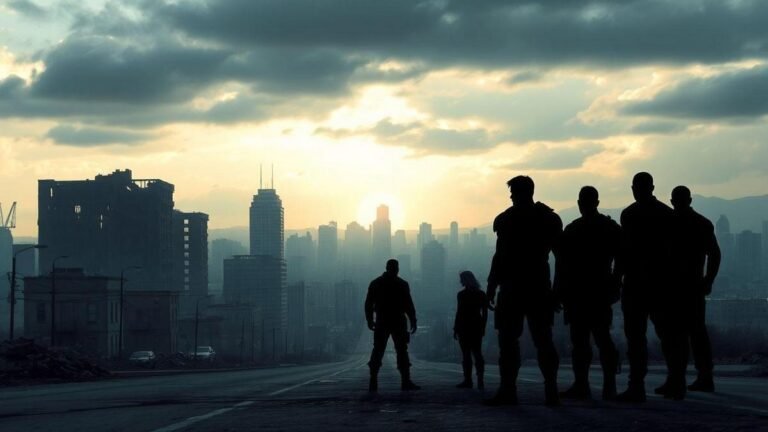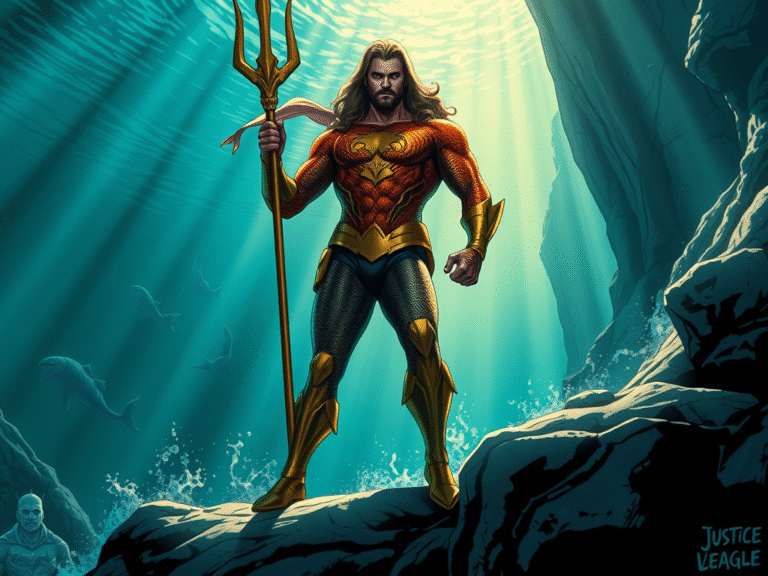How Foreshadowing Shapes Epic Long-Form Comic Stories
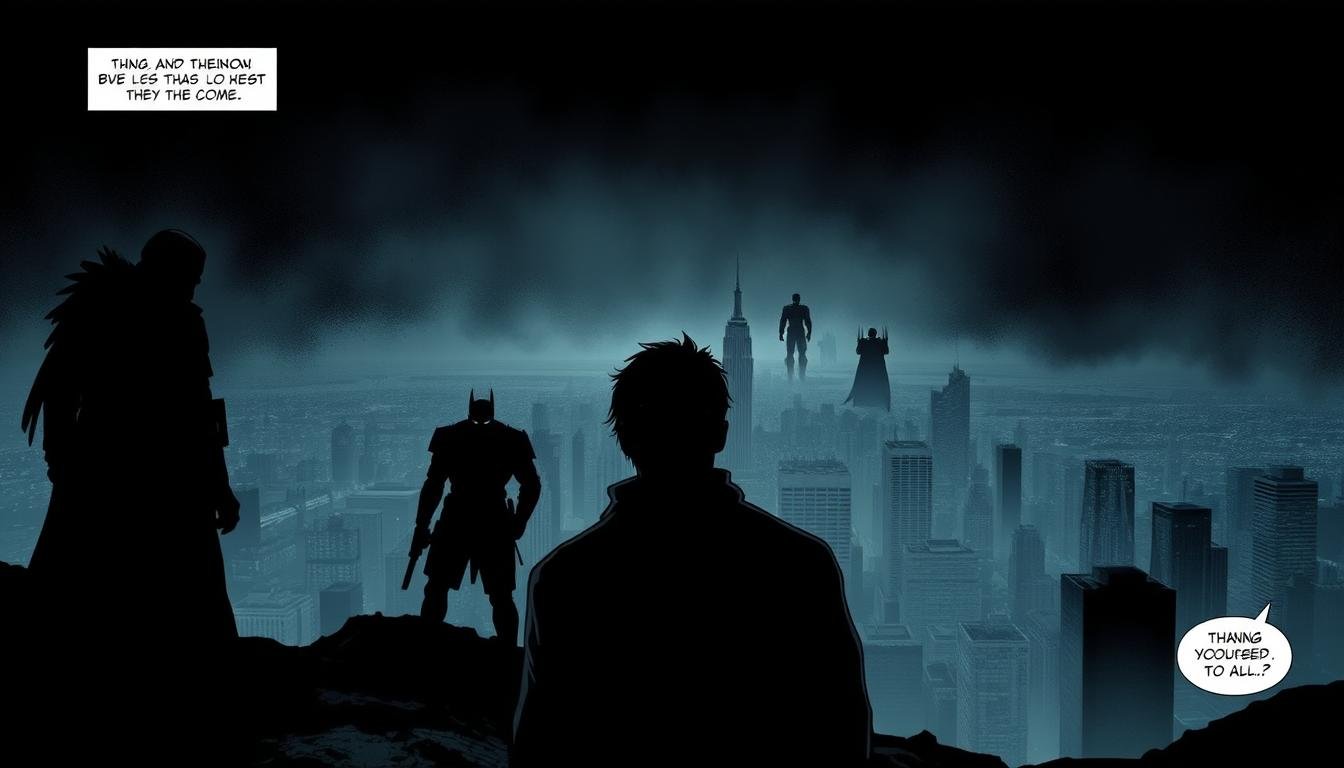
Ever wondered how comic artists keep you guessing and emotionally hooked? Foreshadowing in long-form comics is a key technique. It turns simple stories into deep, engaging experiences.
Visual storytelling is more than just pictures. It’s a mix of subtle clues, symbols, and clever plot building. Skilled comic artists use every panel to guide readers through a thrilling journey.
This guide will take you into the world of foreshadowing in comics. You’ll learn to create stories that grab readers’ attention. You’ll discover how to hint at plot twists through clever visuals and storytelling.
From classic graphic novels to new series, the best stories set up surprises early. By mastering these techniques, your comic art will become a rich, layered story. It will go beyond simple images.
Understanding Visual Storytelling Elements in Comics
Comics are a special form of sequential art. They mix visuals and stories to create amazing experiences. These graphic novels use detailed visuals that spark readers’ imaginations.
Visual storytelling in comics uses key elements to turn simple drawings into engaging stories. The art of sequential art involves special techniques. These techniques guide readers through a detailed visual journey.
Basic Components of Sequential Art
Every graphic novel starts with basic visual storytelling elements:
- Panel composition and layout
- Character design and expressions
- Visual narrative progression
- Color and shading techniques
Role of Visual Narrative Flow
The flow of a comic’s story is crucial. Skilled artists create visual paths that guide the eye smoothly. This ensures readers understand and feel the story well.
Integration of Text and Images
Good visual storytelling blends text and images perfectly. Dialogue, captions, and sound effects work with visuals. Together, they create a deep, engaging story that goes beyond words.
Learning about sequential art’s core principles can help you make graphic novels that grab your audience’s attention.
The Art of Subtle Plot Hints Through Background Details
Comic artists are great at hiding clues in background details. World-building in comics is more than just main characters. It’s about adding layers of meaning through background hints.
Creating subtle hints is all about where you place them. Here are some ways to hide clues:
- Use background signs with mysterious messages
- Place important objects in the background
- Repeat visuals to hint at connections
- Include symbols that hint at future events
Good comic creators know that backgrounds can tell a lot without saying much. These small details make readers feel like they’re uncovering secrets.
| Background Detail Type | Narrative Purpose | Reader Engagement Level |
|---|---|---|
| Newspaper headlines | Provide historical context | High |
| Architectural elements | Suggest cultural background | Medium |
| Character photographs | Reveal relationships | High |
Remember, subtlety is important. You want to spark curiosity without taking away from the main story.
Symbolism and Hidden Messages in Comic Panels
Comics are more than just pictures. They use special techniques to hide deeper meanings. This makes comics a rich and engaging experience for readers.
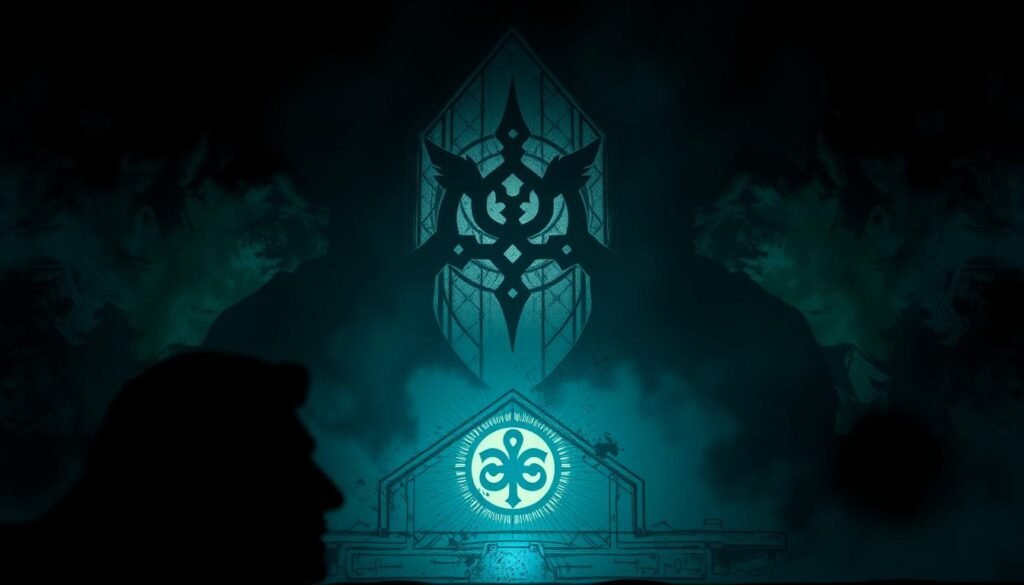
Symbolism in comics is a key way for artists to share complex ideas. They use visuals to tell stories that touch readers’ hearts and minds.
Color Symbolism Techniques
Colors in comics have deep meanings. They can show emotions, tell about characters, and add tension to the story.
- Red: Often represents passion, anger, or danger
- Blue: Typically signifies calm, sadness, or introspection
- Green: Can symbolize growth, hope, or transformation
Object Placement and Meaning
Where objects are placed in comics can reveal a lot. A simple item might hint at big story moments or show what a character is feeling.
“In comics, nothing is placed by accident. Every object tells a story.” – Comic Art Historian
Recurring Visual Motifs
Repeating certain visuals in comics is powerful. These motifs help tie the story together and hint at character growth or themes.
| Visual Motif | Potential Symbolic Meaning |
|---|---|
| Broken Mirror | Internal conflict or fragmented identity |
| Recurring Shadow | Unresolved past or looming threat |
| Specific Geometric Shape | Character’s psychological state |
Learning these techniques can make your comic panels more than just pictures. They become deep, engaging stories that grab and hold your audience’s attention.
Character Design Elements That Telegraph Future Events
Art in comics is a powerful way to tell stories. Your designs can hint at future events without saying a word. This creates excitement and adds depth to your story.
Artists use several ways to hint at future events through character design:
- Color symbolism in costume and background
- Subtle physical transformations
- Symbolic accessories and personal items
- Posture and body language hints
Visual metaphors are key in character design. For example, a character wearing darker clothes might show a moral change. Certain jewelry or markings can hint at hidden stories or plot twists.
Every detail in a comic tells a story. From silhouettes to facial expressions, small changes can signal big story shifts. By mastering these techniques, your characters will keep readers guessing and intrigued.
Great character design doesn’t just show who a character is—it reveals who they might become.
Environmental Storytelling in Comics Backgrounds
Visual storytelling is more than just words. It’s about the details around your characters. These backgrounds become key parts of the story.
The setting in comics tells a lot about the story. It sets the mood and hints at what’s to come. Artists and writers use backgrounds to add depth to the story.
Architectural Narrative Techniques
Architecture offers a chance to tell stories quietly. Your comic’s settings can show a lot about:
- Societal structures
- Historical context
- Character socioeconomic backgrounds
- Potential conflict zones
Weather and Atmospheric Storytelling
Weather isn’t just for looks. Weather conditions can make the story more tense. A storm might mean trouble is coming. But sunshine could mean things are looking up.
Background Character Interactions
Characters in the background add to the story. They might:
- Offer social commentary
- Hint at bigger themes
- Show what’s going on beneath the surface
- Give a sneak peek at what’s next
Learning to use environmental storytelling makes your comic’s background more than just scenery. It becomes a part of the story that adds to the visual experience.
Foreshadowing Long Form Comics Art Through Panel Composition
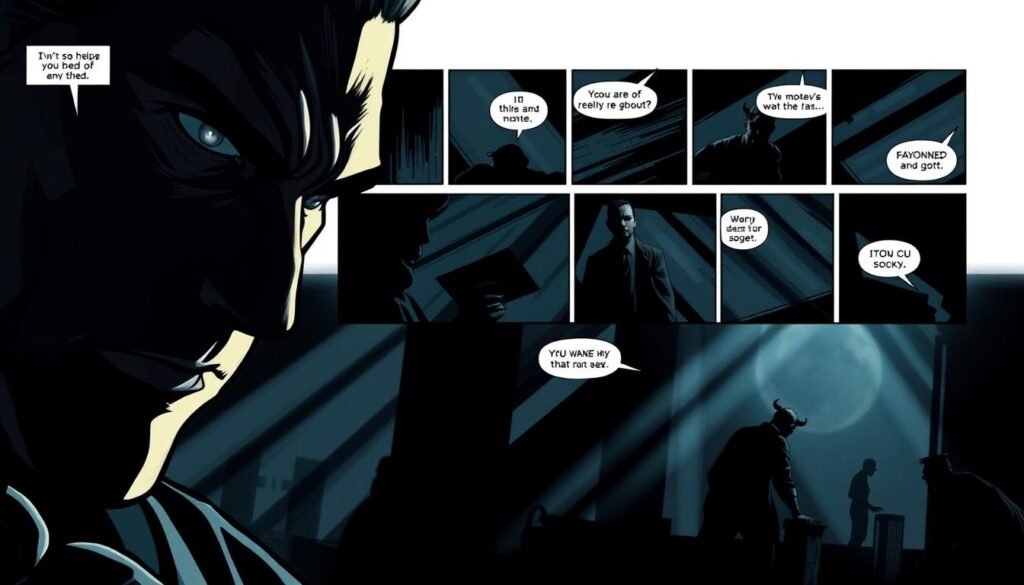
Panel composition is key in sequential art, changing how we see comic stories. It’s a tool in long form comics art that guides the reader. It hints at what’s coming next.
Good panel composition means making smart visual choices. By changing panel size, shape, and where they are, you add depth. This makes readers curious about what’s next.
- Vary panel sizes to highlight important moments
- Use asymmetrical layouts to add tension
- Implement strategic negative space for emotional impact
- Create visual connections between panels
Comic artists know panel composition is more than design. It’s a way to tell a lot without words. By controlling what we see, you can hint at future events that readers will remember.
| Panel Composition Technique | Narrative Purpose | Foreshadowing Potential |
|---|---|---|
| Overlapping Panels | Create Depth and Connection | Suggest Hidden Relationships |
| Repeated Visual Motifs | Build Narrative Consistency | Hint at Future Plot Developments |
| Asymmetrical Layouts | Generate Visual Tension | Indicate Upcoming Conflict |
Mastering these techniques in your comics will make your stories exciting. Readers will be hooked, wanting to find out more.
Using Light and Shadow for Future Plot Hints
Comics are more than just pictures. Light and shadow help tell the story, hinting at what’s to come. They add depth to the story, making it richer and more complex.
Creators use light and shadow to share deep meanings. They play with visuals to build suspense and hint at future events. This way, they tell the story without needing words.
Dramatic Lighting Techniques
Dramatic lighting does more than just light up the page. It has several roles:
- High-contrast lighting creates tension
- Soft shadows hint at deeper emotions
- Directional light shows what’s going on inside a character’s mind
Shadow Symbolism in Storytelling
Shadows are not just dark spots. They can mean:
- Secrets or hidden motives
- Something dangerous is coming
- Inner struggles or conflicts
Contrast and Mood Setting
How light and dark are used changes how we see the story. Different lighting can change our expectations of what’s next.
| Lighting Style | Narrative Impact |
|---|---|
| Harsh Direct Light | Reveals stark conflicts |
| Soft Diffused Light | Suggests emotional complexity |
| Shadowy Environments | Indicates mystery or threat |
Mastering light and shadow turns comics into deep, meaningful stories.
Timeline Manipulation in Visual Narratives
Sequential art breaks new ground in storytelling. In long form comics, playing with time is key. It turns simple tales into complex, layered stories.
Foreshadowing in comics uses time tricks to surprise readers. These tricks help you:
- Blend past, present, and future events seamlessly
- Create narrative tension through temporal shifts
- Provide deeper context for character motivations
- Reveal plot developments through non-linear storytelling
Visual storytellers use several strategies for time manipulation:
| Technique | Purpose | Visual Cue |
|---|---|---|
| Flashbacks | Reveal character history | Soft color palette, blurred edges |
| Flash-forwards | Hint at future events | Desaturated colors, sharp transitions |
| Parallel Timelines | Show interconnected narratives | Alternating panel styles |
Learning these techniques lets you craft stories that keep readers on their toes. Your comic’s plot will evolve in exciting ways.
World-Building Elements That Predict Plot Development
Comics are more than just characters talking. World-building is a key tool that hints at what’s to come. Creators use cultural details, environmental clues, and tech hints to set up complex stories.
Good world-building means placing visual clues that tell us more than meets the eye. Artists weave in story arcs through background details, society, and environment.
Cultural Details and Customs
Cultural settings in comics offer great chances for foreshadowing. Small signs like rituals, social orders, and ways of talking can show hidden issues or conflicts.
- Dress codes showing social levels
- Rituals hinting at power struggles
- Symbolic gestures showing cultural issues
Environmental Worldbuilding
The setting in comics is more than pretty pictures. Landscapes, buildings, and nature can hint at what’s coming through visuals.
| Environmental Element | Narrative Potential |
|---|---|
| Decaying Infrastructure | Societal Decline |
| Technological Ruins | Past Conflict Hints |
| Unusual Landscape Features | Potential Plot Twists |
Technology and Society Hints
Comics show off advanced world-building through tech. The look of machines, communication, and society can hint at deep storylines.
- Advanced transport showing progress
- Communication tech revealing power
- How resources are shared
Character Expression and Body Language Clues
Visual storytelling makes characters come alive by showing their true feelings and secrets. Artists use small body language and facial expressions to tell big stories. This way, they can share complex ideas without words, using just physical signs.
Comic artists are experts at showing deep emotions through art. They use visual clues to hint at what’s coming next. This includes:
- Micro-expressions that hint at underlying tensions
- Posture shifts revealing internal conflicts
- Subtle gesture patterns indicating psychological states
- Nonverbal communication that foreshadows character arcs
To really get character development, you need to watch people closely. Every small muscle movement, eye direction, or unconscious reaction tells us a lot about a character’s real plans.
“In comics, a character’s unspoken language is often more powerful than dialogue.” – Will Eisner
By using these visual storytelling tricks, you can make characters feel real and relatable. The goal is to create a visual language that lets readers understand what’s going on inside a character’s mind. This way, they can follow the story on a deeper level.
Integrating Easter Eggs and Hidden References
Comic artists are experts at adding hidden details to their stories. Easter eggs and hidden references make comics more fun and deep. They reward fans who pay close attention.
Creating these subtle hints is an art. They turn a simple comic into an adventure for readers. It’s like solving a puzzle.
Pop Culture References
Pop culture references add fun layers to your story. They can:
- Create an instant connection with readers
- Add humor
- Hint at bigger themes
Internal Story References
Your comic’s hidden references are powerful. They make the story feel connected and reward close readers.
- Reference earlier scenes
- Show character costumes or backgrounds
- Use recurring symbols
Future Plot Point Hints
Hinting at future storylines is key. Small visual clues can suggest big things to come. These can be simple or complex.
Visual storytelling is about showing, not telling – and the most masterful artists do this through carefully crafted easter eggs.
By using these techniques, your comic will be engaging and full of surprises. Readers will keep coming back to find new things.
Conclusion
Your journey through visual storytelling in comics has given you strong skills. Foreshadowing is not just a skill; it’s an art that makes your stories come alive. It turns simple tales into deep, engaging experiences for readers.
By using subtle hints and clever narrative tricks, you can make comics that reward close attention. Each panel is a chance to hint at what’s coming next. You use color, layout, and details to tell your story. The best foreshadowing is almost hidden, guiding readers without giving too much away.
Remember, subtlety is crucial as you grow in visual storytelling. Aim to create a rich, layered reading experience that invites readers to come back. Try new things, learn from the best, and listen to your gut. With time, your foreshadowing will become a key part of your comics, making them unforgettable.
The skills you’ve picked up, from environmental clues to character hints, are powerful. Use them, make them your own, and see your comics come to life. They’ll go from simple pictures to complex, captivating stories that grab your audience from start to finish.
FAQ
Q: What is foreshadowing in long-form comics?
A: Foreshadowing is a way to hint at future events in comics. It uses visual and narrative clues. These can be background details, symbols, character designs, and panel layouts.
Q: How can I create effective foreshadowing without being too obvious?
A: Be subtle. Use background details and color symbolism. Place objects in a way that only some readers notice. This makes the story richer with each read.
Q: What are some powerful visual techniques for foreshadowing?
A: Use recurring motifs and symbolic colors. Change character designs slightly. Play with panel layouts and environmental clues. These hint at what’s to come.
Q: Can foreshadowing be used in different comic genres?
A: Yes! It works in all genres, from superheroes to everyday stories. The method might change, but the idea stays the same.
Q: How do professional comic artists use foreshadowing?
A: They use it in many ways. Through character expressions, backgrounds, and panel transitions. They also use color and world-building. This creates a story full of hints.
Q: What’s the difference between foreshadowing and giving away plot twists?
A: Foreshadowing hints at future events subtly. Revealing twists too early spoils the surprise. Good foreshadowing lets readers connect the dots later.
Q: How can I practice foreshadowing techniques?
A: Analyze your favorite comics. Notice how artists hint at future events. Try creating detailed backgrounds and using symbols. Focus on visual connections that tell a story.
Q: Are there any common mistakes to avoid when foreshadowing?
A: Don’t be too obvious or clutter panels with too many hints. Make sure your clues fit the story. This keeps the narrative engaging.
